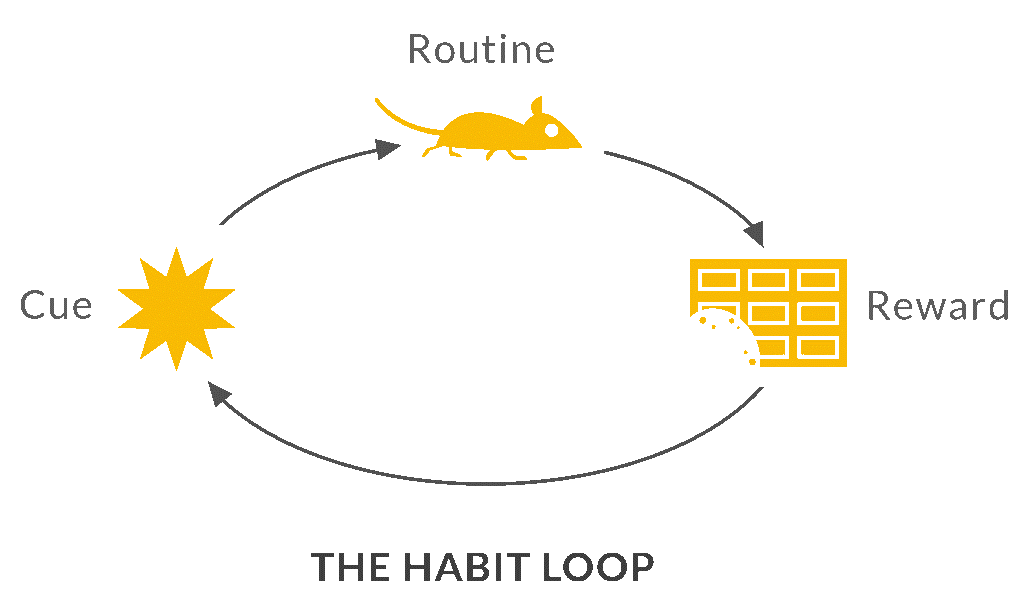Recently, I started to learn how to play the guitar. It’s something I should have done in my teens, but I seems to be studying too much. It was hard. It reminded me of the Bryan Adams song about
‘ got my first real six-string … Played it ’til my fingers bled’. I felt like a five year old as my brain tried to ask my little finger to move, and it wouldn’t. Learning something new is hard, and we often forget it, and it’s easier to put the guitar away and not practice.
When we look at business change – improving innovation, or working better between Product, Marketing and Development – new ways of working is hard. In fact, we’re full of habits, and would prefer to return to our old ways. They may be personal ways of working, or corporate habits.
So how do you break those habits?
Charles Duhigg in his book the Power of Habit describes the three stages of a habit:

1. Cue. A trigger that tells your brain to go into automatic mode, and which routine to use.
2. Routine. Physical, mental, or emotional behaviour that follows the cue
3. Reward. A positive stimulus that tells your brain that the routine works well, and is worth remembering
So when we introduce new ways of working in a business, we need to break these three areas, and give an alternative to each. Often we think about the ‘routine’ – here’s a new form, or process, but not about the Cues and Rewards. The reward, doesn’t have to be monetary, and, in fact, it is more likely to be emotional.
One way to break the habits is to use the four considerations that David Halpern mentions in his book Inside the Nudge Unit. He worked as a behavioural scientist and head of Number 10’s Behavioural Insights Team looking at how to influence without coercion. For example, he tried different ways to encourage people to pay their taxes, and helped the inland revenue use emotional rewards more often than threats. In this way, he came up with this model:
E |
Easy– remove the barriers. Make it easy to change as people are much more likely to do something if it’s easy and low hassle |
|
A |
Attractive to change – make the reward worth it. People are drawn to that which catches their attention and that which is attractive to them |
|
S |
Socially Connected – let others know, involve others.
People are strongly influenced by what others are doing or have done |
|
T |
Timely – give clear steps to change. Interventions are more effective before habits are established or behaviour disrupted for other reasons |
|
So what do I need to DO?
The impact on improving the product function in a business, is to use these four areas in developing your plan to implement change, so beyond designing a new process, think about the cues and rewards.
Firstly, that means thinking of other rewards besides threats. ‘If you don’t follow the process, then you’ll get a low grade at the end of the year’. NO, no. The reward could be that engaging with the innovation workshop means that your ideas are more likely to be in the product.
Secondly, it means looking at new cues. If the sales team comes back from customer meetings with a list of ‘must haves’ on the product, or a pile of criticism, can you look at how to connect the ideas creation process to sales meetings, and link those ideas to sales targets. So the cue, now, is .. if I can commit to a sales impact, my new idea is more likely to get into the product.
Whatever the habit change … that habit change is a personal thing, so you may need multiple approaches for the same goal according to different personalities in the business.
What can I do, now?
Take the EAST framework, and the next time you look at implementing a new idea in the team use it as a checklist to see that the approach to rolling out the idea is more likely to break the old habits.
Sources and REsources
- The Power of Habit: Why We Do What We Do, and How to Change
- Inside the Nudge Unit: How small changes can make a big difference
Other resources around Change include John Kotter’s 8 step model for embedding change in an organisation.
